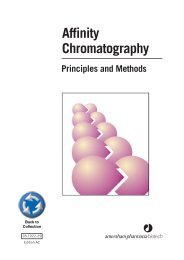Tabletop Rotors and Tubes
Tabletop Rotors and Tubes
Tabletop Rotors and Tubes
You also want an ePaper? Increase the reach of your titles
YUMPU automatically turns print PDFs into web optimized ePapers that Google loves.
Using <strong>Tubes</strong> <strong>and</strong> Accessories<br />
FILLING OPEN-TOP TUBES<br />
OPEN-TOP POLYALLOMER TUBES<br />
Open-top polyallomer tubes are used in swinging bucket <strong>and</strong> fixed<br />
angle rotors.<br />
Swinging Bucket <strong>Rotors</strong><br />
Fill all opposing tubes to the same level.<br />
• Thinwall <strong>Tubes</strong>—Fill to within 2 or 3 mm of the top for proper<br />
tube wall support.<br />
• Thickwall <strong>Tubes</strong>—Fill at least half full.<br />
Fixed Angle <strong>Rotors</strong><br />
Fill all opposing tubes to the same level.<br />
• Thinwall <strong>Tubes</strong> —Must be completely filled; liquid <strong>and</strong> cap for<br />
support of the tube wall is critical.<br />
• Thickwall <strong>Tubes</strong>—Can be partially filled <strong>and</strong> centrifuged as<br />
indicated in the applicable rotor manual. Speed reductions may be<br />
required for these partially filled tubes. For greater fill volumes<br />
<strong>and</strong> faster speeds, tube caps should be used. Refer to the applicable<br />
rotor manual for fill volumes <strong>and</strong> speed limitations.<br />
OTHER OPEN-TOP TUBES<br />
Open-top tubes of other materials can also be used in fixed angle<br />
<strong>and</strong> swinging bucket rotors. (Vertical tube <strong>and</strong> near vertical tube<br />
rotors use only OptiSeal or Quick-Seal tubes.) Fill these tubes as<br />
indicated below.<br />
<strong>Tabletop</strong> Ultracentrifuge <strong>Rotors</strong> <strong>and</strong> <strong>Tubes</strong><br />
3-11

















